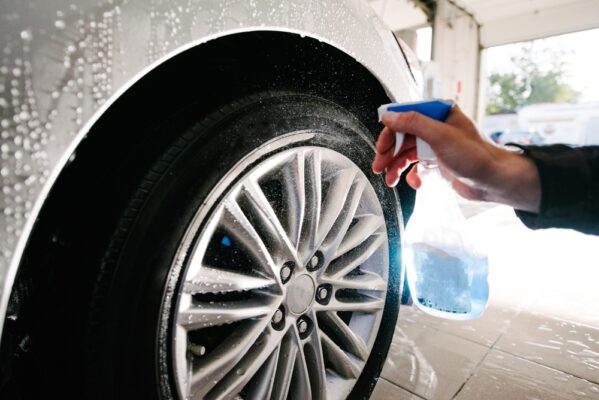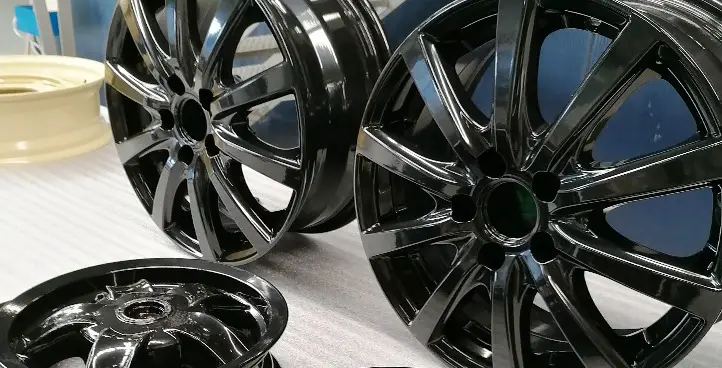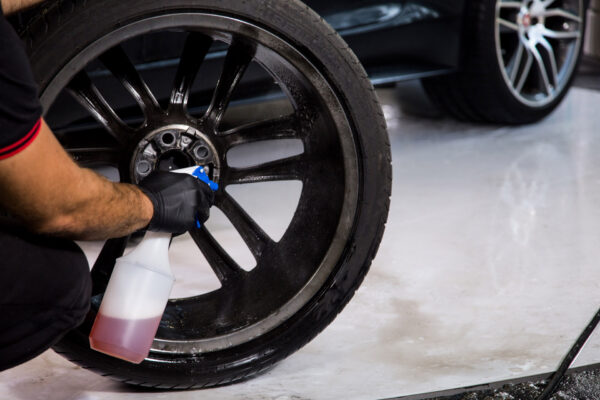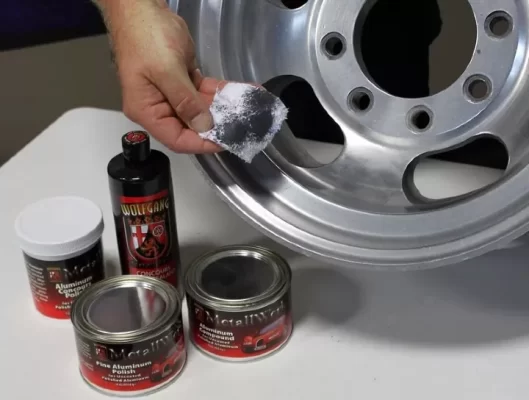To remove disks from a vehicle, first ensure the car is parked on a flat, stable surface and the parking brake is engaged. Place wheel chocks behind the disks to prevent rolling. Before lifting the vehicle, use a lug wrench to slightly loosen the lug nuts on the wheel you’re removing. Then, use a jack to lift the vehicle and place the jack stands under the frame for support, ensuring the car is stable. Once the vehicle is securely elevated, fully remove the lug nuts and take off the wheel. Always prioritize safety by double-checking the stability of the vehicle on the jack stands before proceeding.

What are the most common methods for removing spray paint?
Removing paint from wheels can be done at home or by a professional. Whether they are alloy or aluminum, it can be a meticulous task, but several methods can make the job easier and more effective. Here’s a guide to the most common methods for removing:
Chemical paint removers:
Let’s check:
Paint stripper and paint thinner
A powerful chemical designed for removal. Apply a generous amount to the paint, following the manufacturer’s instructions. Effective for dissolving spray paint and other types of paint. Use a clean cloth to apply it to the affected areas.
Smart strip and adhesive remover
A less harsh, eco-friendly paint removers that remove spray paint without causing damage. Sometimes useful to remove paint if it’s also adhesive-based.
Step-by-step guide:
- Preparation: wear gloves and glasses. Work in a well-ventilated area.
- Application: apply the paint remover to the paint, ensuring you cover all areas.
- Wait time: allow it to sit for the recommended time to loosen the paint.
- Scrubbing: use a brush attachment or wire brush to scrub off the paint. For stubborn spots, use a knife.
- Cleaning: wipe down the area with clean towels and a dry cloth to remove any residue.
Pressure washing or power washing:
Pressure washer: a high-pressure water jet can remove spray paint, especially when dealing with large surfaces. Be cautious to avoid damaging the wheel’s surface.
Power washer: similar to a pressure washer but may have different settings and attachments for more controlled cleaning.
Paint removal process:
- Preparation: clean the disks with a pressure washer to remove dirt.
- Application: use the washer to target areas with paint. Use a brush attachment if necessary.
- Inspection: check for any remaining paint and reapply if needed.
- Drying: dry the disks with a clean towel.

Manual scrubbing
Steel wool: remove spray paint, especially from aluminum wheels. Use in a circular motion.
Wire brush: helps in scraping off thicker layers of paint. Be gentle to avoid scratching.
Rubber gloves: protect your hands from chemicals and debris.
Rubbing alcohol or mineral spirits: can be used for final touches to remove residual paint.
Paint removal process
- Preparation: wear glasses and gloves.
- Scrubbing: use steel wool or a wire brush to scrub the paint. Apply rubbing alcohol or mineral spirits to loosen stubborn paint.
- Cleaning: wipe the area with a clean towel and cloth.
Wrap and elbow grease
Plastic wrap: use wrap to cover the painted areas after applying a paint remover. This helps keep the remover from drying out and increases its effectiveness.
Elbow grease: sometimes, removing requires a good amount of physical effort. Use a knife or scrub brush as needed.
Paint removal process:
- Preparation: apply paint remover and cover with plastic wrap.
- Wait time: let it sit as directed by the product instructions.
- Scrubbing: remove the wrap and scrub the paint with a brush or knife.
- Cleaning: wipe down with clean towels and a cloth.
Final steps
- Inspection: ensure all paint is removed and inspect for any remaining residues.
- Polishing: polish the disks to restore their finish after paint removal.
- Safety: always work in a well-ventilated area and use the right tools to make the job easier.
Each method has its advantages, and the best choice may depend on the type of paint, the wheel material, and your personal preferences. By following these steps and using the right tools, you can effectively detach paint from your disks and achieve a clean, polished look.
What factors should I consider when choosing a paint removal method?
When choosing a paint removal method for aluminum wheels, several factors should be considered to ensure effective and safe results. The choice of paint remover depends largely on the type of paint used and the wheel material.
Type of paint and coating
Understanding whether you’re removing spray paint or a different type of coating is crucial. Spray paint might require a specific paint stripper designed for lighter coatings, while more durable finishes might need stronger chemicals like a paint thinner.
Wheel material
Aluminum wheels or paint from alloy wheels can be sensitive to certain chemicals. Ensure that the paint stripper or paint remover you choose is safe for use on these materials to avoid corrosion or damage.

Effectiveness
Some products, like Smart Strip, are designed to remove spray paint without harmful fumes or damage to the wheel. They might be preferable if you’re working in a confined space or want a more eco-friendly option.
Application and removal tools
Using a power washer or pressure washer can help remove loosened paint from the disks, especially in all the nooks and crannies. However, these tools should be used with caution to avoid damaging the wheels.
Work environment
Ensure good lighting, such as a work light, and proper ventilation when using chemicals. This helps in spotting areas where the paint hasn’t been fully removed and ensures safety during the process.
Alternative methods
For adhesive residues or other tough spots, an adhesive remover might be necessary alongside the paint remover to effectively remove the paint.
Skill level and safety
Finally, consider your own experience and comfort with using these chemicals and tools. Improper use can lead to damage or personal injury, so if in doubt, consulting a professional might be the best choice.
Choosing the right method for paint removal on wheels involves balancing effectiveness, safety, and the specific needs of the material you’re working with.
Can I remove paint from the wheels at home, or should I take them to a professional?
Removing paint from alloy wheels can be done at home or by a professional, depending on your comfort level and the tools available. For a DIY approach, you can use a paint stripper or paint remover to remove spray paint. Start by applying the paint stripper to the wheels and let it sit for the recommended time to loosen the paint. Afterward, use a brush or a power washer to remove the softened paint from the wheels.
If the spray paint is particularly stubborn, you might need a paint thinner to remove all the paint effectively. Make sure to work in a well-ventilated area and use a work light to see any remaining paint on the wheels underneath. While this method can be effective, it requires careful handling of chemicals and the right equipment.
Taking the wheels to a professional can ensure a thorough job, as they have specialized tools and expertise to remove the paint without damaging the alloy wheels. Professionals can also offer additional services like sanding and refinishing to restore the original look of your wheels.
Ultimately, whether you choose to detach paint from your wheels at home or seek professional help depends on your skills, the condition of the wheels, and the quality of the spray paint used.

How much does it typically cost to have paint removed from wheels professionally?
The cost of having paint removed from wheels professionally can vary depending on several factors, including the method used and the extent of the paint to be removed. Typically, professional services employ techniques like using a paint stripper, paint remover, or power washer to effectively remove spray paint or other coatings.
On average, the cost to remove spray paint from a set of four wheels ranges from $100 to $300. This price can increase if the wheels require more intensive cleaning or if additional services like refinishing or repainting are requested. Factors that influence the cost include the type of spray paint or coating, the condition of the wheels, and the specific equipment used, such as a power washer.
For specialized finishes or more challenging removal jobs, some professionals might charge extra, particularly if the paint has been applied thickly or unevenly. It’s also worth noting that some shops may offer discounts if the wheels are removed from the vehicle beforehand, saving them time and labour.
Overall, the investment in professional removal services ensures a thorough job that can restore the appearance of the wheels without risking damage from improper techniques or harsh chemicals.
What are some tips for preventing paint from sticking to wheels in the future?
Preventing paint from sticking to your disks in the future involves a few key practices that help protect the wheel surface and make removing spray paint easier if it does happen. Here are some tips to consider:
Proper cleaning and protective coatings
Regularly clean your wheels to remove dirt, brake dust, and grime that can cause spray paint to adhere more strongly. Use mild soaps and avoid harsh chemicals that could damage the wheel’s finish.
Applying a protective coating or sealant designed for disks can create a barrier that prevents paint and other contaminants from sticking. These coatings make it easier to detach colour if your discs are accidentally sprayed.
Wheel covers or masks
If you’re working in an environment where spray colour might be used, consider using wheel covers or masks to protect your wheels. This is especially useful during DIY projects where spray colour overspray could be a concern.
Avoiding DIY paint jobs
If you’re not experienced with using spray colour, it’s best to avoid DIY paint jobs on or near your wheels. Even a small amount of overspray can be difficult to remove and may require the use of a paint remover or paint stripper.
Regular inspection and maintenance
Regularly inspect your wheels for signs of paint or other contaminants. Promptly remove the colour if you notice any, using appropriate methods and tools to prevent it from bonding permanently to the surface.
Parking and storage
When possible, park your vehicle in a garage or a covered area to minimize exposure to the elements and reduce the risk of accidental spray colour exposure.
By following these tips, you can help protect your wheels from unwanted spray paint and make it easier to maintain their appearance over time.

How do I remove paint from steel wheels?
For steel wheels, using a paint stripper or paint remover is often the most effective method. Here’s the process:
Preparation: clean the wheels thoroughly to remove any dirt or grease that could interfere with the paint remover.
Application: apply a paint stripper designed for metal surfaces. Be sure to follow the manufacturer’s instructions for safe use.
Removal: allow the stripper to work for the recommended time, then use a wire brush or a scraper to remove the colour. For stubborn areas, a second application may be necessary.
Finishing: After removing the spray paint, rinse the wheels with water to neutralize any remaining chemicals and sand them lightly to smooth the surface.
How do I remove paint from chrome wheels?
Chrome wheels are more delicate, so you need to be careful to avoid damaging the chrome finish:
Gentle cleaners: start with mild cleaners that are safe for chrome. Avoid abrasive tools that can scratch the surface.
Paint remover: if mild cleaners don’t work, use a paint remover formulated for chrome. Apply carefully, following all safety precautions.
Rinse and buff: after removing the colour, rinse thoroughly with water and buff the chrome to restore its shine. For tough spray paint, consider using a clay bar or specialized chrome polish.
How do I remove paint from plastic wheels?
Plastic wheels or wheel covers require extra caution to avoid damaging the material:
Mild solutions: use a plastic-safe paint remover or a mixture of soapy water to start. Avoid strong chemicals that can melt or discolour plastic.
Soft tools: use soft cloths or plastic scrapers to gently remove spray paint. Do not use metal tools, as they can scratch or gouge the plastic.
Rinse and protect: after removing the colour, rinse the wheels thoroughly. Consider applying a plastic protector to help shield against future damage.
For all types of wheels, it’s crucial to work in a well-ventilated area and use appropriate personal protective equipment when handling chemicals. If you’re unsure about the process or concerned about damaging your wheels, consulting a professional may be the best option.
What tools or equipment are essential to remove spray paint?
Removing spray paint from wheels requires a combination of essential tools and equipment to ensure the job is done efficiently and safely. One of the primary tools needed is a high-quality stripper or remover, specifically formulated for removing spray paint. This chemical solution helps to break down the spray paint, making it easier to remove.
Safety equipment is crucial when dealing with paint strippers and removing spray paint. This includes gloves, safety goggles, and a mask to protect from fumes and potential skin contact. Additionally, a drop cloth or plastic sheeting should be used to protect the surrounding area from any overspray or drips.
A wire brush or a nylon brush is useful for scrubbing the disks after the spray paint has been softened by the stripper. For more stubborn spots, a plastic scraper can help lift the colour without damaging the wheel’s surface.
A pressure washer or a garden hose with a high-pressure nozzle can be used to rinse off the loosened spray paint and any remaining paint stripper residue. This step ensures that the wheels are thoroughly cleaned before any new paint or finish is applied.
Lastly, a soft cloth or sponge is essential for the final cleaning and polishing of the wheels after all the spray paint has been removed. This ensures a smooth, clean surface, ready for any further treatment or refinishing.
Are there any specific types of brushes or pads recommended for paint removal?
When removing spray paint from surfaces, choosing the right brushes or pads is crucial for effective paint removal without causing damage. For removing spray paint, wire brushes are often recommended due to their durability and ability to scrub off tough layers of spray paint. These brushes come in various shapes and sizes, making it easier to reach all areas, including nooks and crannies where spray paint may have settled.
Nylon brushes are another excellent option to remove the paint, particularly for surfaces that require a gentler touch. Nylon brushes are less abrasive than wire brushes and are effective at removing spray paint from delicate surfaces without causing scratches or damage.
In addition to brushes, pads such as abrasive scrubbing pads can be used for removing spray paint. These pads are available in different levels of abrasiveness, allowing you to choose the appropriate level of scrubbing power for the surface you’re working on. For tougher spray paint removal tasks, a more abrasive pad may be necessary, while finer pads are suitable for lighter spray paint or more delicate surfaces.
Another useful tool to remove the paint is a plastic scraper or a putty knife. These can help lift and peel away layers of spray paint after it has been loosened with a paint remover or stripper.
Combining these brushes and pads with the appropriate paint remover or stripper will yield the best results in removing spray paint effectively and safely.

What is the condition of the wheel?
The condition of the wheel is crucial for ensuring a smooth and safe ride. Regular maintenance is necessary to keep the wheel in top shape. One common issue that can affect the wheel is the build-up of dirt, grime, and rust. To address this, using a high-quality spray can be very effective.
Firstly, it’s essential to inspect the wheel for any visible signs of damage, such as cracks, bends, or excessive wear. If everything looks fine, proceed with cleaning. Start by spraying the wheel with a degreasing solution to remove any oil or grease. Let the spray sit for a few minutes to break down the grime. Afterward, use a brush to scrub off the dirt, ensuring you reach all the nooks and crannies.
Next, rinse the wheel thoroughly with water and dry it completely. If you notice any rust spots, a rust-removal spray can come in handy. Apply the spray to the affected areas and scrub gently to remove the rust.
Finally, to protect the wheel and enhance its appearance, consider applying a protective spray. This can help prevent future rusting and keep the wheel looking shiny and new. Regularly repeating this process will ensure that your wheel remains in excellent condition.
It can be a meticulous but rewarding process, ensuring a clean and fresh base for a new finish. To achieve the best results, follow these key steps:
Safety while removing spray paint from wheels
When removing disks from a vehicle, safety should always be a top priority. One crucial aspect of safety is wearing safety glasses. These protect your eyes from dust, dirt, and debris that may become airborne during the process, especially when loosening lug nuts or if there are any unexpected mishaps.
In addition to glasses, other precautions include ensuring the vehicle is on a flat, stable surface and using wheel chocks to prevent rolling. It’s also important to use proper jack and jack stands to securely lift and support the vehicle, avoiding the risk of the car falling. Ensuring you have all necessary tools and equipment ready before starting can also help maintain a safe and efficient wheel removal process.
By prioritizing safety and wearing glasses, you reduce the risk of injury and ensure a smoother, safer experience when working on your vehicle.
Conclusion
In conclusion, removing paint from disks is a crucial step in restoring their appearance and ensuring they are free from unwanted coatings. Whether you’re dealing with old layers of paint or need to remove spray paint that accidentally got on your wheels, careful preparation and the right techniques are key. Using appropriate tools and methods, you can effectively remove spray paint and any other unwanted finishes, leaving the wheels clean and ready for refinishing or further treatment. Consistently applying the best practices for removing paint helps maintain the integrity and aesthetics of the wheels.

Matthew Edward is a professional painter who loves to paint and wants to share useful tips and tricks which he had learned in many years of experience in painting. He also used many products that can be used for painting he has tried and tested each and every product to give an unbias opinion about it in his review. This blog is very useful for those newbies who want to learn painting without making mistakes.






